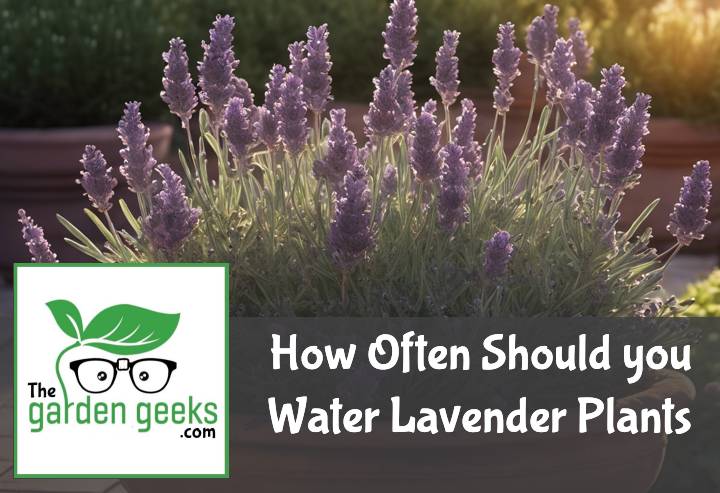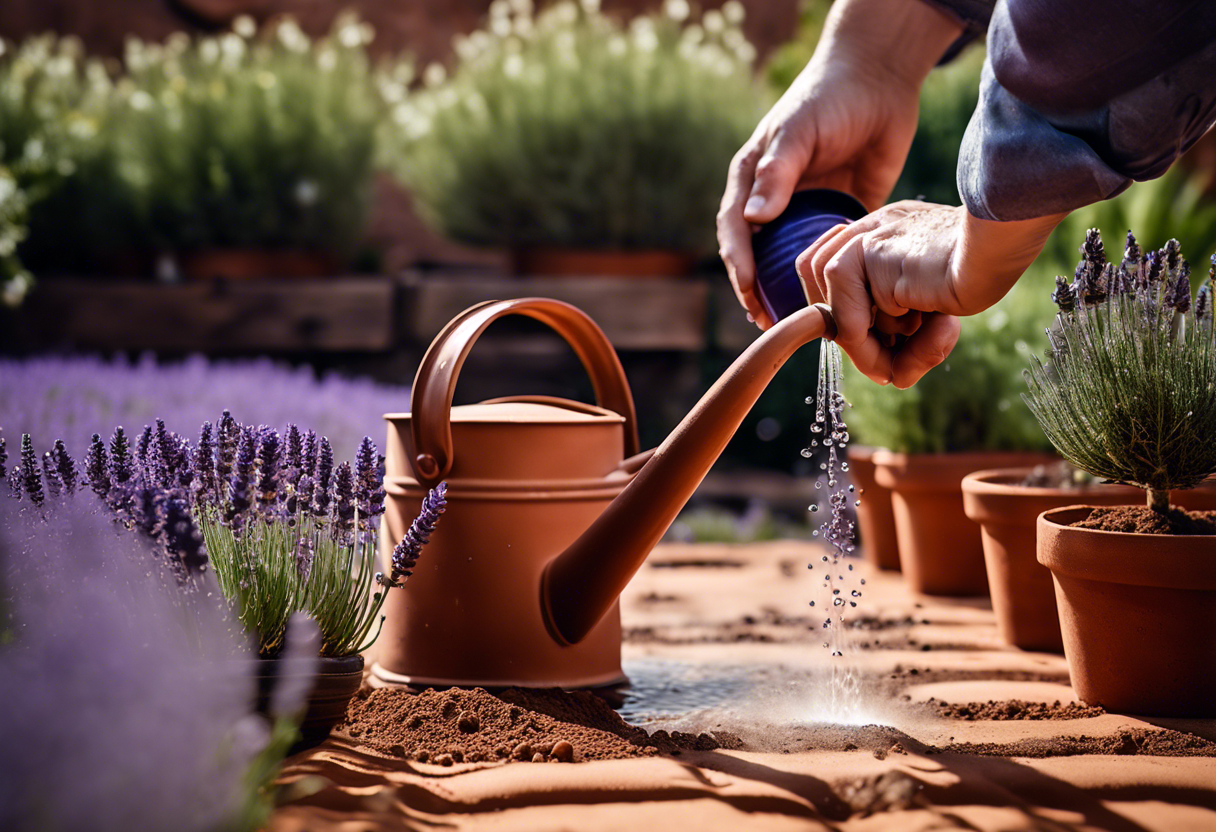Ever found yourself in the gardening section of a store, staring at a pot of lavender and wondering, How Often Should you Water Lavender Plants? Well, you’re not alone. We’ve all been there, faced with the challenge of keeping these purple beauties alive.
In this blog post, we’ll dive into understanding the watering needs of these fragrant plants. So grab your watering cans and put on your gardening gloves. It’s time to become a lavender-loving pro! “Keep reading about How Often Should you Water Lavender Plants?”
Key Takeaways
- Lavender plants typically need watering once or twice a week.
- In hotter climates, they may require more frequent watering.
- Overwatering can lead to root rot, so it’s important to let the soil dry out between waterings.
- During winter months, lavender plants usually need less water.
- Use well-draining soil to prevent waterlogging and ensure the plant’s health.
Understanding Lavender Plants
Let’s talk about our fragrant friend, the lavender plant. These beauties have unique characteristics that make them a joy to grow. But, understanding these quirks is key to watering them right. We’ll be diving into their origin, nature, and the different types of lavenders. So buckle up for a crash course in lavender plant characteristics and basics of lavender care.
The Origin and Nature of Lavender
Lavender plants hail from the Mediterranean region. Picture hot summers, mild winters, and well-drained soil – that’s where these guys feel at home. This origin of lavender plays a big role in their watering needs.
Their natural habitat is not known for heavy rainfall but rather sporadic showers followed by sunshine. Hence, lavenders are more drought-tolerant than you might think! The nature of lavender plants influences their watering needs significantly.
Types of Lavender Plants
Now onto the fun part – there’s more than one type of lavender! Each with its own water preferences. English lavenders are pretty chill about water; they can handle a bit more moisture compared to others.
On the other hand, French and Spanish lavenders prefer it on the drier side. They’re like “Hold up on the H2O please!” So remember, when figuring out how often should you water lavender plants, consider what type you’ve got growing in your garden!
Watering Needs of Lavender Plants
Lavender plants are a bit like Goldilocks, they don’t want too much or too little water, but just the right amount. Watering lavender plants is a delicate balance that requires understanding their specific needs. It’s all part of lavender plant care and knowing how to water lavender properly.
Factors Influencing Watering Frequency
When it comes to lavender watering frequency, several factors come into play. First off, climate plays a big role. If you’re living in a hot and dry area, your lavender might need more frequent watering compared to those in cooler climates.
Soil type also affects how often you should water your lavender plants. Fast-draining soils may require more frequent watering than heavier clay soils. Lastly, the maturity of the plant matters too! Younger plants typically need more water than established ones.
Signs of Overwatering and Underwatering
Now let’s talk about what happens when things go south with watering. Overwatered lavenders can show signs like yellow leaves and root rot – not a pretty sight! On the flip side, underwatered lavenders might have wilting leaves and stunted growth.
Being able to diagnose these lavender watering issues is crucial for maintaining healthy lavenders. So remember folks, keep an eye out for these signs and adjust your watering accordingly!
How Often Should You Water Lavender Plants?
So, you’re wondering how often should you water lavender plants? Well, it’s not as simple as a set schedule. Factors like whether your lavenders are indoor or outdoor, the season, and even soil type can affect their thirst level.
Indoor vs. Outdoor Lavenders
Indoor lavender plants are like that friend who always forgets to drink enough water. They need a bit more attention and regular watering compared to their outdoor counterparts. This is because they don’t have access to natural rainfall and might be in a warmer, drier environment.
On the flip side, outdoor lavenders are the tough guys of the plant world. They’re used to dealing with whatever Mother Nature throws at them. So they typically require less frequent watering than indoor lavenders.
Seasonal Variations in Watering Frequency
Now let’s talk seasons. In summer, your lavender is going to be thirstier than a marathon runner on a hot day. It’s important to keep an eye on them and water more frequently during these hotter months.
Winter is another story though. It’s like lavender’s hibernation time – they need less water. But remember not to neglect them completely! A little drink now and then will keep them happy.
Soil Type and Its Impact on Watering
And lastly, let’s get down and dirty with soil types. If you’ve got clay soil, you’re in luck! Clay holds onto water longer so your lavender won’t need watering as often.
But if you’re dealing with sandy soil – well, that stuff drains faster than a sink without a plug! Your lavender will need more frequent watering to stay hydrated.
So there you have it folks! Remember this isn’t one-size-fits-all advice but hopefully it gives you some guidance on how often should you water lavender plants.
Tips for Properly Watering Lavender Plants
Proper watering is a critical aspect of lavender plant care. It’s not just about dousing them with H2O, but knowing when and how to do it right. This is the secret sauce to maintaining lavender health and ensuring they bloom beautifully.
Best Time to Water Lavenders
So, when is the ideal watering time for lavenders? Well, it depends on a couple of factors like climate and season. In hot climates or during summer, early morning or late evening watering works best. This helps prevent water evaporation and ensures your lavenders get the hydration they need.
On the flip side, in cooler climates or seasons, you can be a bit more flexible with your seasonal lavender watering schedule. Just remember that overwatering can lead to root rot, so moderation is key!
Techniques for Effective Watering
Now let’s talk about effective watering techniques for lavenders. One popular method is drip irrigation. This slow and steady approach ensures deep soil penetration, which is great for lavender roots.
Another technique worth trying out is deep watering. Unlike shallow sprinkling, this method encourages roots to grow deeper into the soil, promoting stronger plants.
Remember folks, improving lavender hydration isn’t rocket science! With these tips in mind, you’ll be well on your way to mastering how often should you water lavender plants!
Common Mistakes While Watering Lavenders
When it comes to lavender plant care, there’s a fine line between just right and oops-I-drowned-it. Yep, we’re talking about the common watering mistakes folks make with their lavender plants.
Overwatering: Causes and Consequences
Overwatering is like throwing your lavender a pool party that never ends. The result? A waterlogged mess! Overwatered lavender symptoms can include yellow leaves and root rot. It’s like giving your plant a one-way ticket to Fungusville.
But don’t worry, preventing overwatering isn’t rocket science. Just remember, lavenders are not fish! They don’t need to swim in water all day long. So next time you reach for that watering can, think twice.
Underwatering: Causes and Consequences
On the flip side, underwatering is like sending your lavender on a desert trek without any water bottle. Signs of this include wilting leaves and stunted growth – basically, your plant looking as parched as a dried prune.
But hey, no need to panic! Preventing underwatering is easy peasy lemon squeezy. Just keep an eye on your plant and give it a drink when it looks thirsty. Remember, how often should you water lavender plants is key here!
So whether you’re dealing with an overwatered or dehydrated lavender plant, remember these lavender watering tips: Not too much, not too little – just right!
To Wrap Up
So, we’ve journeyed through the lavender fields together, and hopefully, you now have a clear answer to How Often Should you Water Lavender Plants. Remember, treat your lavender like a cool cat that prefers sipping its water rather than gulping it down.
In essence, keep it light and breezy with the watering can. Your lavender will thank you for it! Now go forth with your newfound knowledge and let your garden thrive!





